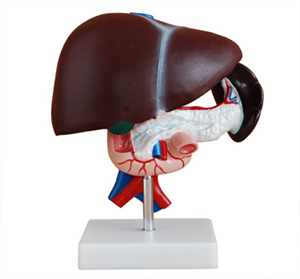Homepageпјҡ NEWS >> Can the hepatopancreatic duodenal model provide doctors with more intuitive clinical simulation training?
The application of hepatopancreatic duodenal model in clinical simulation training has indeed provided doctors with a more intuitive and efficient learning platform. Through precise anatomical and functional simulations, these models not only help physicians better understand complex abdominal organs, but also significantly improve their skills and confidence in actual clinical operations.
1. Precise anatomical structure and clinical application
The hepatopancreatoduodenal model helps doctors intuitively understand the position relationship and function of these organs in the human body through the highly reducible organs such as liver, pancreas and duodenum. The three-dimensional presentation of these structures allows doctors to observe and learn the anatomical characteristics of abdominal organs from different angles, laying a solid foundation for practical operation. The study data show that doctors who use this high-precision model to learn can more quickly master the diagnosis and treatment of gastroenter-related diseases.

Hepatopancreatic duodenal model
2. Simulate complex surgical procedures
The application of hepatopancreatic duodenal model is of great value in surgical training, especially in complex surgeries such as liver resection, pancreas resection and biliary duct reconstruction. Doctors can practice these difficult procedures repeatedly in a risk-free environment, reducing the error rate in actual surgery. By simulating these operations, doctors not only improve their surgical skills, but are also better able to deal with complications during surgery.
3. Enhance clinical judgment and emergency response ability
The training of hepatopancreatic duodenal model is helpful to improve doctors' quick judgment of pathological conditions. For example, in a simulated liver tumor removal surgery, doctors can formulate the most appropriate surgical plan based on the actual lesions shown in the model. Data support shows that doctors trained in this simulation are able to make faster and more accurate clinical decisions when dealing with real cases and reduce complication rates during surgery.
4. Improve surgical accuracy and patient safety
Model training can effectively improve the accuracy of surgery. In real surgery, doctors operate based on the experience of the model simulation, and can more accurately deal with complex organ relationships and vascular structures. This kind of simulation training is essential to reduce accidental injury and complications in surgery, especially in hepatobiliary and pancreatic surgery. Clinical studies have shown that doctors trained with the model have a lower failure rate in practice, and patients recover better after surgery.
5. Academic research and data support
The data show that the application of hepatopancreatic duodenal model not only enhances the practical ability of doctors, but also provides a new perspective for academic research. The experience and data accumulated by doctors in simulation training can provide important support for the development of new techniques in abdominal surgery. For example, the use of models helps to evaluate the feasibility of new surgical methods or drug treatment regimens, thereby driving advances in the field of medicine.
conclusion
The hepatopancreatic duodenal model provides a more intuitive and practical clinical simulation training platform for doctors to better understand the anatomy of abdominal organs and improve their surgical skills and clinical judgment. Through this simulation training, doctors can effectively reduce mistakes in actual operation, improve surgical safety and patient recovery effect, and ultimately promote the comprehensive development of medical education and clinical treatment.